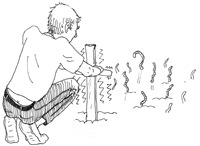STRANGEBUTTRUE- Worm grunting: Act like mole; succeed like one

DRAWING BY DEBORAH DERR McCLINTOCK
Q. What do "worm grunters" know that you may not about scaring up fishing worms by the hundreds or even thousands? Wouldn't waiting for a good downpour do it? –T. Sawyer
A. The rain strategy turns out to be folklore. New experiments have verified the approach of these professional bait collectors in Florida's Panhandle, says Kenneth Catania in Scientific American magazine. They've mastered the art of getting worms out of their burrows to be collected and sold as bait. The practice has been handed down for generations and today is celebrated with annual worm-grunting festivals, worm-grunting tee shirts, and the crowning of a worm-grunting queen.
Ground vibrations are used to drive worms to the surface via pounding a wooden stake into the soil and then rubbing it with a flat piece of metal called a rooping iron.
Studies have shown that the worms feel the ground vibrations and interpret them as a predatory mole coming from below and so out they crawl– at a lighting speed for worms. (A single mole will eat an estimated 7,000 worms per year.) So effective is grunting that the National Forest Service in Florida, worried about possible overharvesting of the large earthworms (Diplocardia mississippiensis), now requires a permit for operating in the area.
Q. "Water water everywhere, and too many drops to drink," with apologies to Samuel Taylor Coleridge. But how much water is too much? –T. Frederick
A. There are 332,500,000 cubic miles of water on the Earth's surface, though less than 1 percent of it is fresh and accessible, says Rebecca Coffee in Discover magazine. Lately, even more water has been identified in vast reservoirs beneath the ocean floor, perhaps even more water under the oceans than in them.
Although it's been advised that people drink eight glasses of water daily, scientific evidence for this is lacking. A 1945 report recommended that Americans consume about "1 milliliter of water for each calorie of food," amounting to about 8-10 cups a day, but the report added that much of that water can come from food–a nuance many of us apparently missed. Drinking significantly more than is needed might actually prompt a call to "waterholics anonymous," since this can lead to "water intoxication" and perhaps even cause fatal cerebral pulmonary edema.
"Amateur marathon runners have died this way," cautions Coffee.
Q. How long can someone survive without food or water? –R. Crusoe
A. In theory, when you run out of body fat, protein and carbohydrates, your energyless body shuts down, says Jessica Hamzelou of New Scientist magazine. But clinician Jeremy Powell-Tuck, who fed American magician David Blaine after his 2003 44-day starvation stunt in London, says you die well before that. Fat people would be able to survive longer only if they had enough vital water-soluble B vitamins to help metabolize fat stores. So it is possible for a person to die of starvation and still be obese.
One of the longest starvations on record was by Irish hunger-striker Kieran Doherty in 1981, who died after fasting for 73 days. Supplied with vitamins and water, people have been known to survive more than a year without eating. With vitamins but with no water, survival drops. A human can go for weeks without food, but without water, the volume of blood in the body drops and with it blood
pressure, explains Michael Sawka of the U.S. Army Research Institute of Environmental Medicine.
"Blood becomes thicker and stickier, making it harder to pump around the body, so the heart rate increases to compensate. Even in a cool environment, a person wouldn't last for more than a week without water," Sawka writes.
~
Send Strange questions to brothers Bill and Rich at [email protected]
#